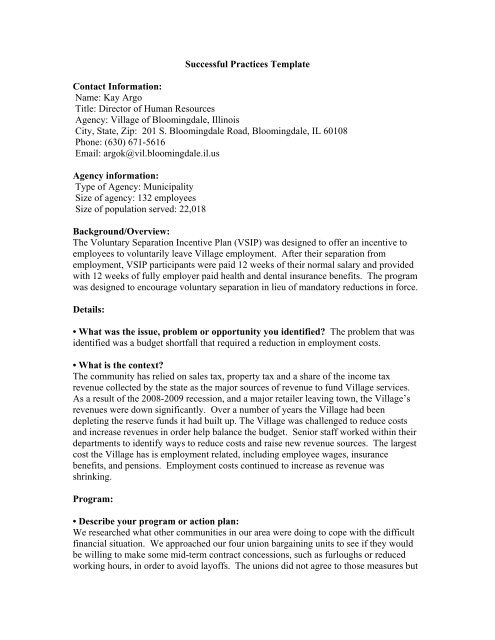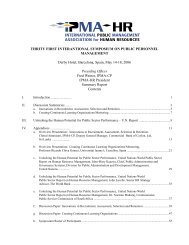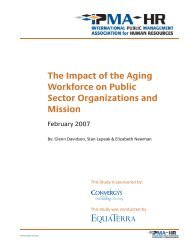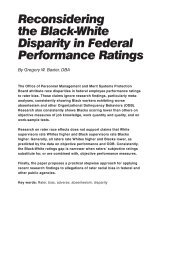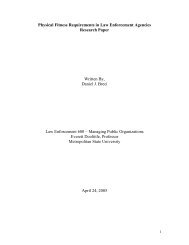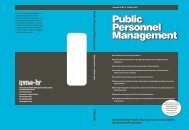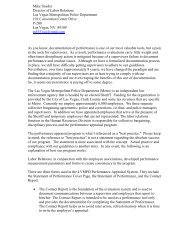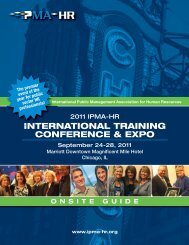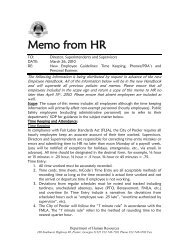Voluntary Separation Incentive Program - IPMA
Voluntary Separation Incentive Program - IPMA
Voluntary Separation Incentive Program - IPMA
You also want an ePaper? Increase the reach of your titles
YUMPU automatically turns print PDFs into web optimized ePapers that Google loves.
Successful Practices TemplateContact Information:Name: Kay ArgoTitle: Director of Human ResourcesAgency: Village of Bloomingdale, IllinoisCity, State, Zip: 201 S. Bloomingdale Road, Bloomingdale, IL 60108Phone: (630) 671-5616Email: argok@vil.bloomingdale.il.usAgency information:Type of Agency: MunicipalitySize of agency: 132 employeesSize of population served: 22,018Background/Overview:The <strong>Voluntary</strong> <strong>Separation</strong> <strong>Incentive</strong> Plan (VSIP) was designed to offer an incentive toemployees to voluntarily leave Village employment. After their separation fromemployment, VSIP participants were paid 12 weeks of their normal salary and providedwith 12 weeks of fully employer paid health and dental insurance benefits. The programwas designed to encourage voluntary separation in lieu of mandatory reductions in force.Details:• What was the issue, problem or opportunity you identified? The problem that wasidentified was a budget shortfall that required a reduction in employment costs.• What is the context?The community has relied on sales tax, property tax and a share of the income taxrevenue collected by the state as the major sources of revenue to fund Village services.As a result of the 2008-2009 recession, and a major retailer leaving town, the Village’srevenues were down significantly. Over a number of years the Village had beendepleting the reserve funds it had built up. The Village was challenged to reduce costsand increase revenues in order help balance the budget. Senior staff worked within theirdepartments to identify ways to reduce costs and raise new revenue sources. The largestcost the Village has is employment related, including employee wages, insurancebenefits, and pensions. Employment costs continued to increase as revenue wasshrinking.<strong>Program</strong>:• Describe your program or action plan:We researched what other communities in our area were doing to cope with the difficultfinancial situation. We approached our four union bargaining units to see if they wouldbe willing to make some mid-term contract concessions, such as furloughs or reducedworking hours, in order to avoid layoffs. The unions did not agree to those measures but
did not oppose the Village offering the VSIP since it was voluntary rather thanmandatory.• What steps did you take to get started?A plan document was drafted and reviewed by legal counsel for compliance withemployment laws. The Village Board of Trustees approved the plan. All regular fulltimeemployees with at least one year of Village service were offered the plan. AFrequently Asked Questions (FAQ) and plan document were emailed to each employee.Employees were encouraged to meet with the HR Director to get questions answered.Employees were given about 45 days to put in their request to take the plan. The Villagethen decided how many of the applications to grant. Employees were notified of theirselection and allowed up to six months to separate their employment.Outcomes:• What were the measurable results?The plan was offered to all full-time employees who numbered about 134 at the time.Ten employees applied to take the plan. All were approved. Nine out of ten employeeseventually separated. Of those who separated all were eligible and took their retirementpension. The one who decided not to take the plan was not of retirement age andremained on the job.• What positive or negative outcomes did you see?The Village was able to reduce its full-time workforce without resorting to a mandatoryreduction in force. Those employees who had been considering retirement for a numberof years had an extra incentive to do so. These employees were at top pay and benefitrates. The downside was that only two of the positions were refilled and the workloadwas assumed by the staff that remained without any additional staffing help.• What metrics did you use to assess the result?Savings of approximately $740,000 were projected for the FY2011 budget with annualsavings in excess of $1.00 million thereafter by not replacing the departing employees.The Village’s total operating expenses for FY11 budget were estimated at $24,163,505,with personnel services making up over $14 million of that number.• Describe any other results you saw, either positive or negative.The VSIP was one tool that was used to reduced employment expenses. It was not theonly measure that was taken to address rising employment costs. After the program wasoffered we went back to the unions to negotiate again with them to avoid layoffs. Threeout of four unions agreed to mid-term contract negotiations which resulted in a one yearpay freeze with the guarantee of no layoffs during that time.


